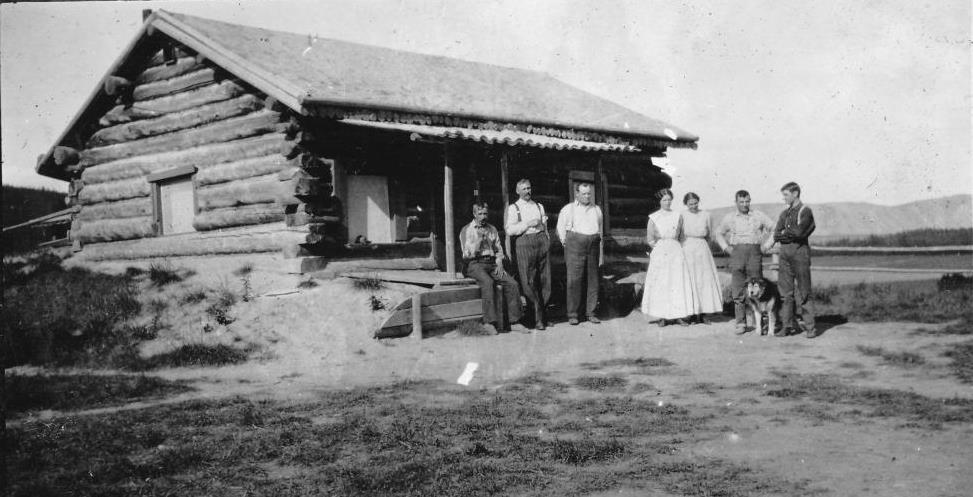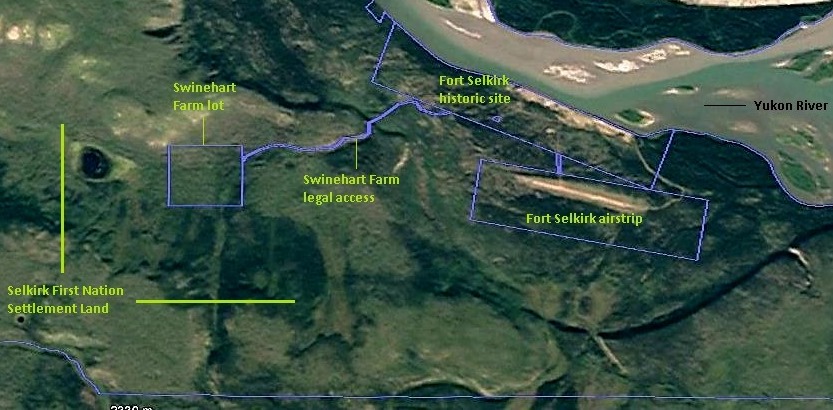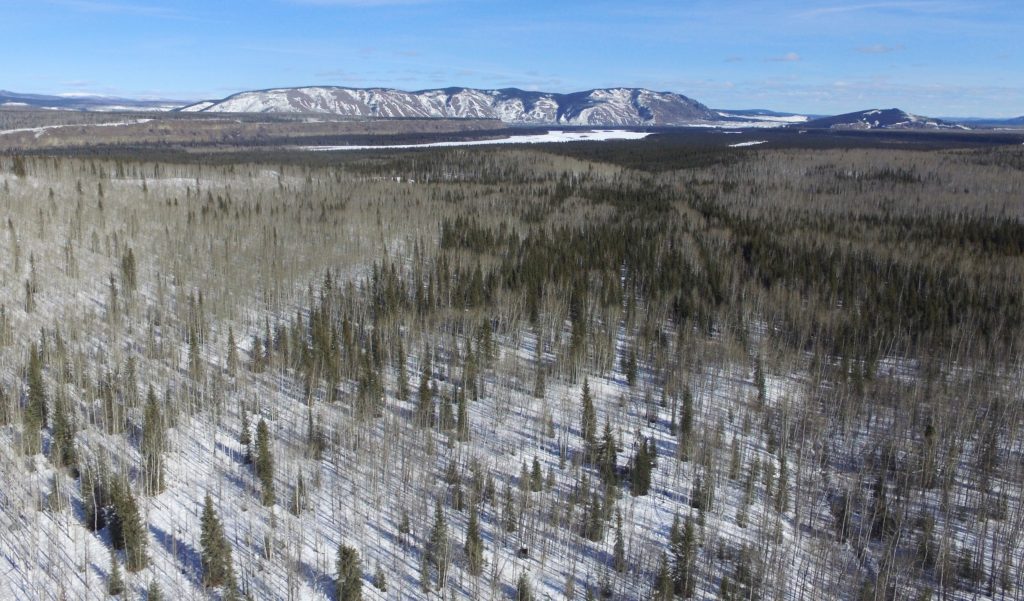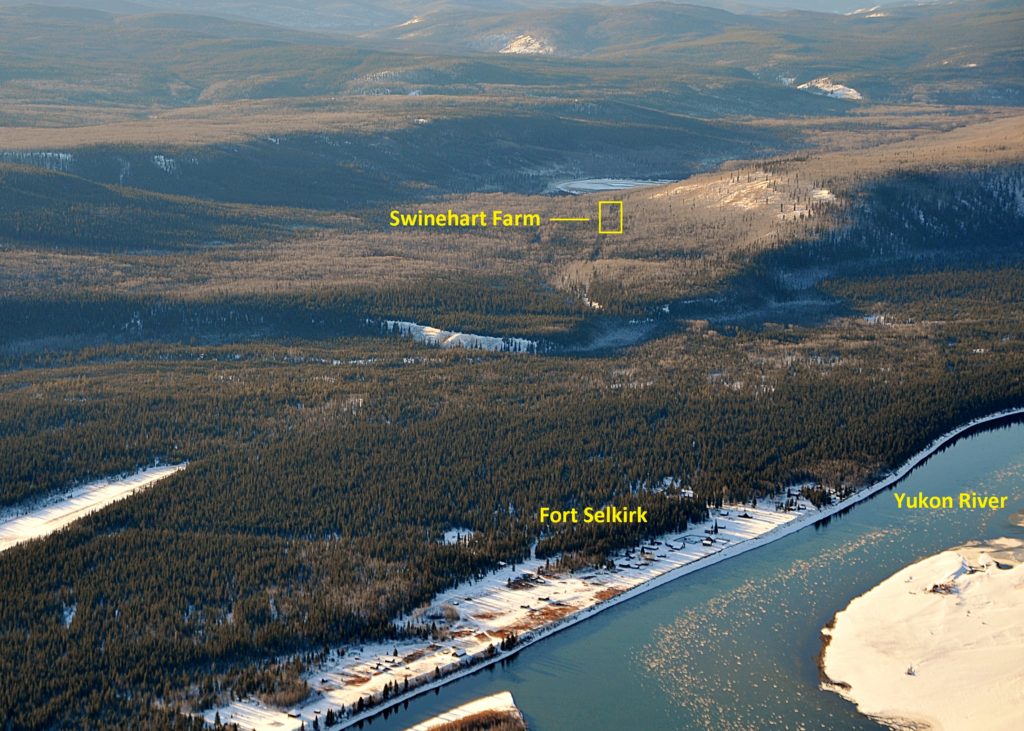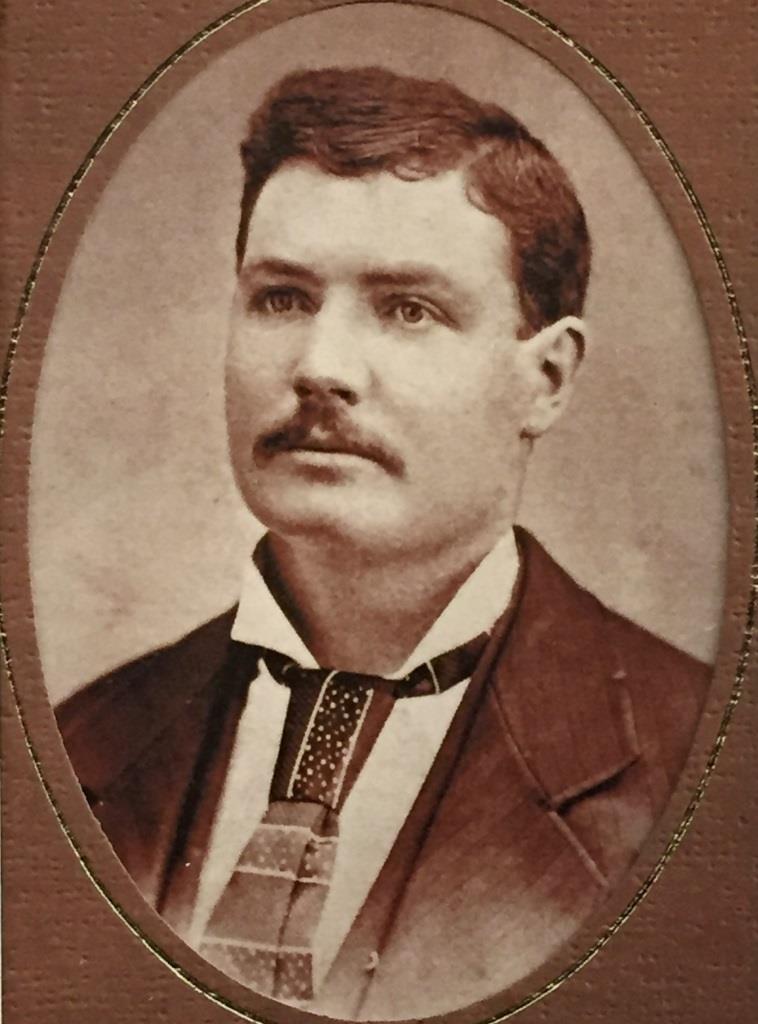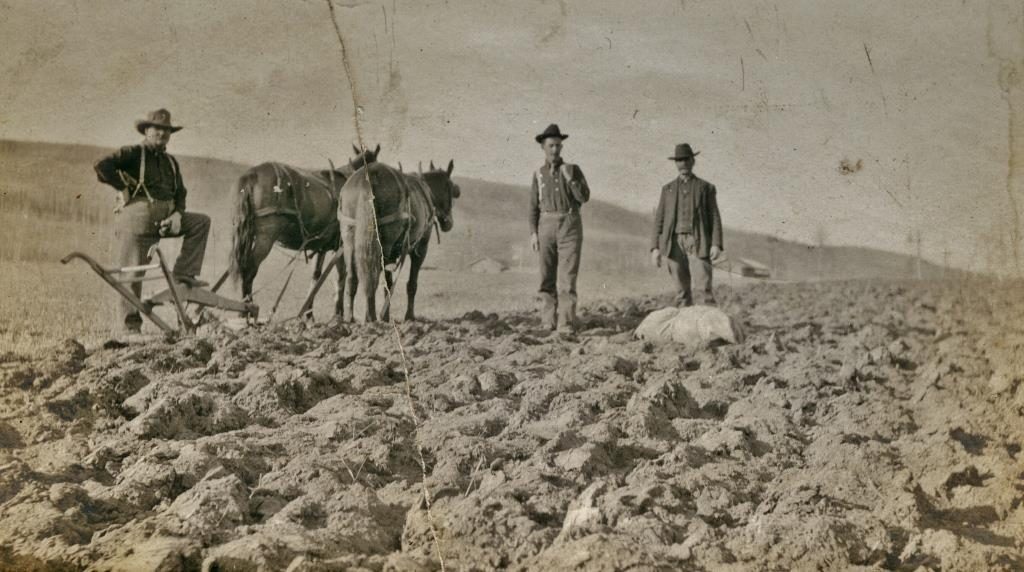The Swinehart Farm – part 2
Establishing the Swinehart Farm (1898 – 1902)
The Swinehart party’s arrival at Fort Selkirk and beginning the development of the Swinehart Farm added to the swarm of activity that was occurring at Fort Selkirk in 1898 as a result of the Klondike gold rush. The small community until then consisted of not much more than an Anglican church and school, Arthur Harper’s trading post and a few cabins. In the fall of 1898 Fort Selkirk swelled with the arrival of the 200-man Yukon Field Force, along with civilian contractors, and the construction of its complex of buildings. A Northwest Mounted Police post and the Roman Catholic Church were also built in this year. The next year the Yukon Telegraph line came through Fort Selkirk and the Swinehart Farm, bringing more activity and a new communication link with the outside world.
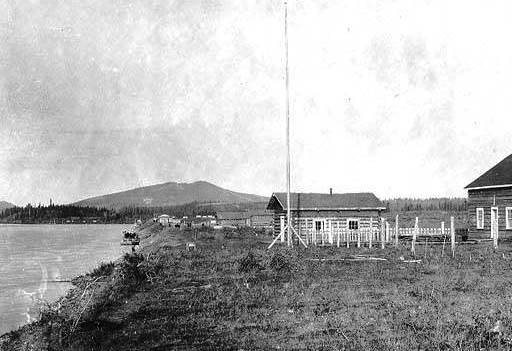
(Eric Hegg photo, University of Washington Libraries, Special Collections, Hegg 727A)
Shortly after landing at Fort Selkirk, Swinehart began to develop his farm. The land tenure situation for the farm is very intriguing, and continues so to this day. Earlier that year, on March 2, 1898, a man from Juneau named Frank Bach had submitted an application for one square mile (640 acres) of land at an unidentified location “in the vicinity of Fort Selkirk for an experimental farm”. Bach was a prominent businessman, a judge, and for a time the mayor at Douglas Island near Juneau.
Bach had gone to the Klondike at least as early as 1897 and must have come across this piece of land off the beaten path near Fort Selkirk that appealed to him. He returned to Juneau in October 1897 with a group that included Jack Dalton who left Dawson because of warnings of a lean winter due to lack of provisions there. Mt. Bach near the Hutchi Lakes was named that year in his honor because he “helped Jack Dalton make the Dalton Trail through here to the Yukon River”. The nature of Bach’s relationship with Dalton and what assistance he provided him is not clear.
Frank Bach submitted his application for the Fort Selkirk land, likely from Juneau, at the same time that William Swinehart was preparing to leave there for the Yukon. The two men must have had a fairly close relationship in Juneau, as Swinehart left his daughter Vivian there to live with the Bach family.
There is no record of what happened with Bach’s land application of March 1898, but it is clear that William Swinehart began developing his farm on the land that summer. He started living at the site on June 21, 1898, within a week of arriving at Fort Selkirk, so there seems little doubt that Bach told Swinehart about the parcel of land he had applied for and encouraged him to occupy it under some sort of arrangement. Three years later, on July 18, 1901, Swinehart applied for 80 acres at this location west of Fort Selkirk “in lieu of [Bach’s application] of 2nd March 1898”. The story behind this substitution of land applications, as well as for the three-year gap between them, is not known.
In July 1902, Swinehart paid the balance of the purchase price for the land to the government, and in August the parcel called Lot 7 Group 4 was surveyed for him. Later that year, on November 26, 1902, a Dominion Lands Grant (title to the land) was issued, but surprisingly it was not to Swinehart. For whatever reason, perhaps the agreement with Frank Bach, the title was issued to Bach, and Swinehart never owned the land he developed, lived on and farmed for 16 years, and died on.
The valley containing the Swinehart Farm has a trail from Fort Selkirk running through it that connects back up to the Yukon River about eight kilometers downstream from the settlement. It was part of the winter trail between the coast and the Klondike region before the Whitehorse-Dawson Overland Trail was in place. This trail became upgraded to a road to the Swinehart Farm and beyond, likely in 1899 to support the Yukon Telegraph line that was being built through to Dawson City. Rather than following along the Yukon River as it normally did, the telegraph line took an easier route west through the valley and across the newly-developing Swinehart Farm.
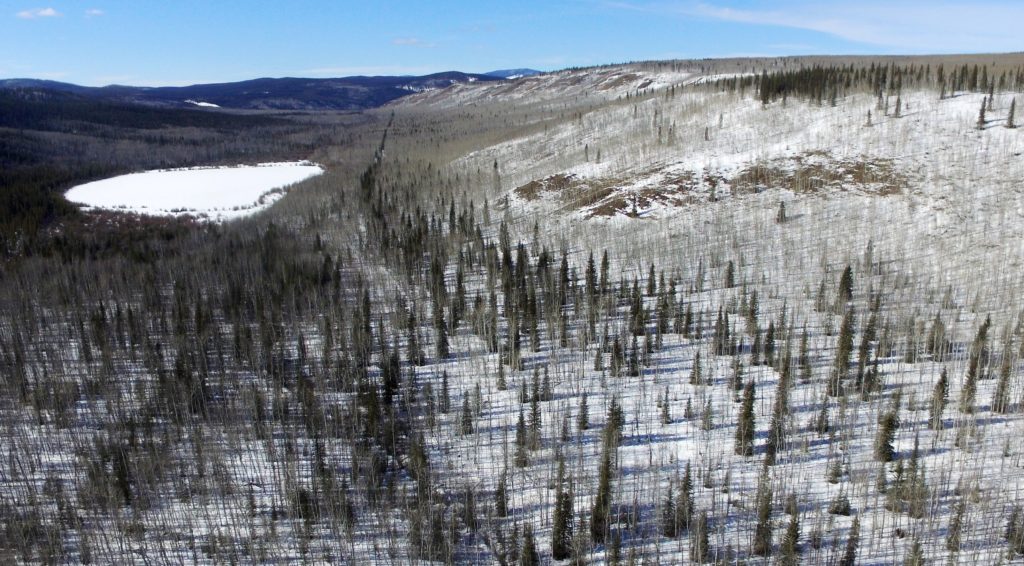
(©Neal Allison photo)
There is no known arrangement with Swinehart for the telegraph line crossing the farm land, and he had no land tenure to bargain with, but he may have welcomed the improved access as well as the clearing provided by it. When the Overland Trail from Whitehorse to Dawson City was built in 1902, it bypassed Fort Selkirk by several kilometers, but this route through the Swinehart Farm was surveyed out as a road allowance for what was called the Selkirk cut-off. This was a road to connect the community to the Overland Trail further to the north and across the Yukon River.
The 1902 survey plan for the Swinehart Farm property shows a cabin, the road allowance, and about 15 acres fenced and under cultivation, a portion of it off of the property. This field, though now completely overgrown, still shows up plainly against the surrounding vegetation on modern air photos. Therefore it appears that this may be the extent of the land that was ever developed for farming, even though other sources quote somewhat more acreage in production. Some of these sources also reference meadow land, so it is possible that a large meadow on an adjacent lot to the west was also used by Swinehart, perhaps for harvesting of wild hay.
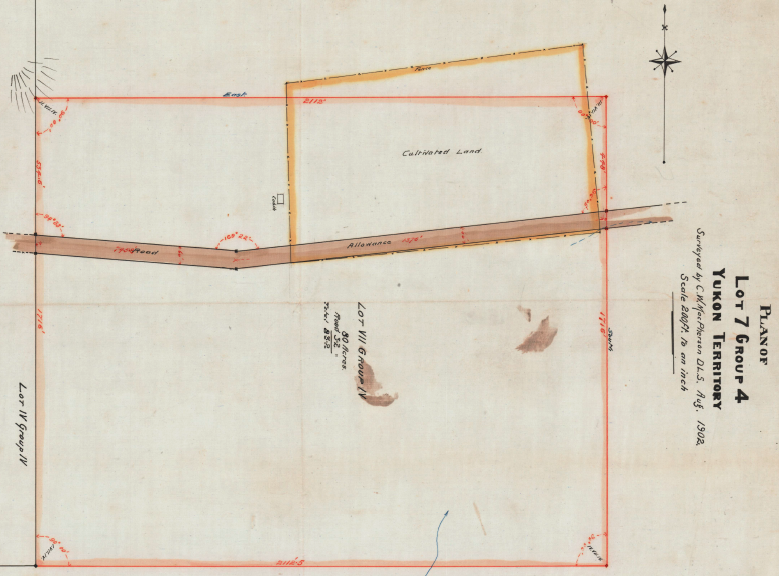
The choice of this site three kilometers from the river for a farming endeavor might seem curious when almost all other such enterprises in the central Yukon are located beside the rivers. On a visit to the Swinehart Farm site with Dale Bradley, owner of the nearby Pelly River Ranch, his answer to this was immediate. The location had good soil, a nearby water source for irrigation, and good access to Fort Selkirk, where riverboats and winter stages could take the farm produce to markets in Dawson City and roadhouses on the Overland Trail. Equally or more important, the farm’s elevation likely provided a buffer from late spring and early fall frosts in the river valley bottom, a condition that Fort Selkirk was known to be susceptible to.
It is not known how much all four men, William and son Guy Swinehart along with William’s brother-in-law Ham Kline and William “Billy” Thompson, were involved in the establishment of the Swinehart Farm. Not a lot was produced at the farm as it was being developed and it wouldn’t have paid much during those early years, so some men appear to have taken on occasional other work. In 1899, Ham Kline was one of the first discoverers of gold on Nansen Creek west of Carmacks. Billy Thompson worked for a time during the gold rush piloting boats through Miles Canyon and the Whitehorse Rapids.
The Swinehart Farm must have held some attraction or allegiance, however, because three years after arriving in the Yukon all four men were there when the 1901 Canada Census was taken. While William was listed as the ‘head’ of the household and Guy as his son, Kline was listed as a partner, Thompson as an employee, and another man, 40-year old Frank Chapman from Kansas, also as an employee. Also present at the farm were William Swinehart’s two oldest daughters, Leta and Vivian, an interesting sub-plot to the story that will be explored later.
The involvement of Frank Chapman and Billy Thompson in the Swinehart Farm is an interesting side note because this led to further pioneer farming in the Yukon. Frank Chapman went on to own the well-known Pelly Farm (also known as Pelly River Ranch) with his partner Peter Oleson beginning around 1910, and is thought to be the primary early developer of that farm. Billy Thompson encouraged his younger sister Lura and her husband J.C. Wilkinson to join him in the Yukon, which they did in 1917. The Wilkinsons also later owned the Pelly Farm and, along with their two sons and daughter, became well-known trappers, hunting guides and river outfitters in addition to being farmers.
Updated October 7, 2023
